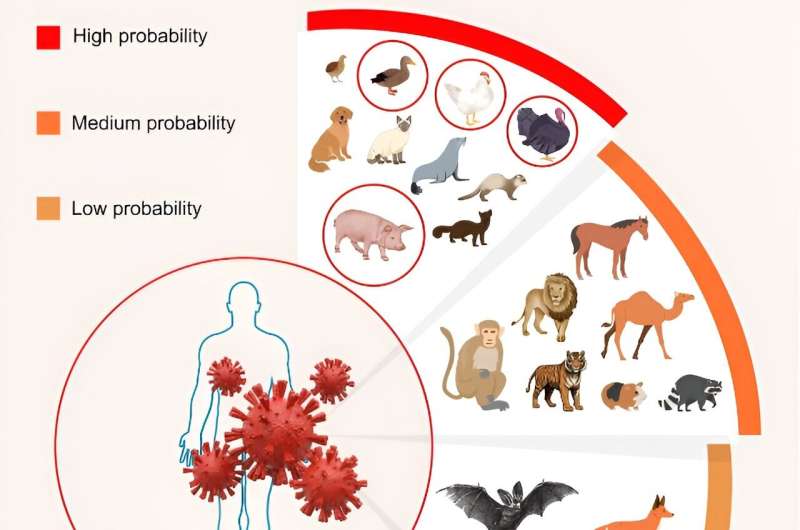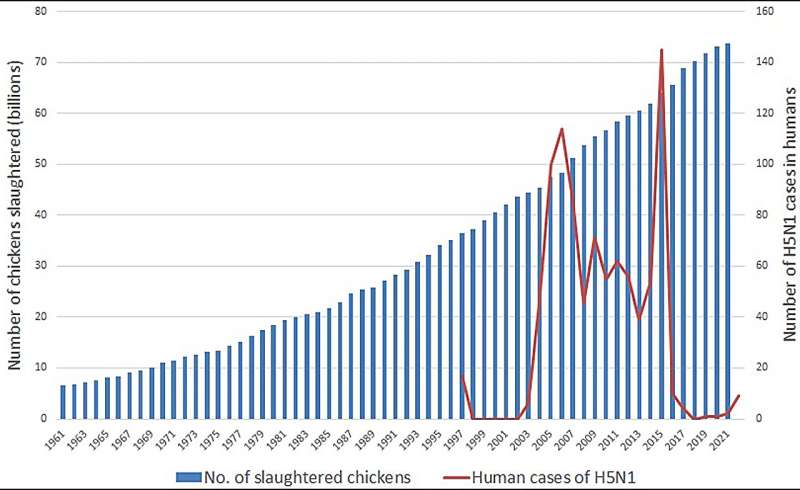January 8, 2024 feature
This article has been reviewed according to Science X's editorial process and policies. Editors have highlighted the following attributes while ensuring the content's credibility:
fact-checked
peer-reviewed publication
trusted source
proofread
In the interests of animal welfare and public health, researchers make a case for improved farm animal conditions

Research shows that three-quarters of emerging infectious diseases are passed from animals to humans; an illness of this type is known as zoonosis (plural: zoonoses). Farm animals, especially pigs and poultry, pose a high risk of zoonotic infection.
Zoonoses involve numerous types of animals. Industrialized intensive animal farming (IIAF) destroys wild animal habitats, leading to closer association among wild animals and people, thus raising the risk of infection transmission by wild animals.
However, while existing research shows that approximately 75% of zoonoses can be traced to wild animal species, the rest originate from domesticated animals, including farmed animals. On many farms throughout the world that raise poultry and pigs for meat, animals are kept in crowded, unhygienic conditions, which raise zoonotic risk.
In a new review, researchers from the U.K.'s University of Winchester and Australia's Griffith University examine the risks of keeping chickens and pigs in intensive farming environments and in crowded quarters. The work is published in Frontiers in Veterinary Science.
Zoonotic agents and high-risk conditions
Zoonotic agents include bacteria, fungi, parasites, protozoa, and viruses that incubate in animal hosts. Of these agents, viruses—especially influenza viruses, which infect the digestive and respiratory tracts of their host animals and humans—represent the most serious risk.
Zoonotic spread frequently occurs through humans' direct contact with the saliva or droppings of an infected animal, or through environmental contamination.
Overall, the conditions that heighten zoonosis risk throughout the world include:
- Record numbers of humans (8 billion as of November 2022); farmed chickens (25 billion at any one time) and farmed pigs (1 billion at any one time)
- Close human proximity to farmed animals
- Suboptimal breeding and living conditions for farmed chickens and pigs
- The worldwide presence and internationalization of IIAF
- IIAF disruption of ecosystems due to its outsized land and resource requirements
- Specific locations of IIAF operations
- Misconceptions that farmed animals both present and are subject to low risk
The new study discusses in detail the ramifications of each of these factors.
Well-known examples of zoonoses include outbreaks of Asian flu (H2N2 virus) in the late 1950s and Hong Kong flu (H3N2 virus) in the late 1960s, both transmitted to humans via infected chickens; and swine flu (H1N1 virus, transmitted to humans via infected pigs), which originated in 1919 and is still in circulation.
Antimicrobial use makes matters worse. A 2023 study in PLoS Global Public Health shows that globally, farmed animals consume 73% of all antimicrobials in use, and that by 2030 this percentage is expected to grow by 8%.

A brief overview of influenza viruses
A paper published in Viruses in 2023 delineates four types of influenza viruses, each of which has a unique genome and affects a specific group of hosts:
- Type A (extensive variety of birds and mammals)
- Type B (humans and pigs)
- Type C (humans, pigs and seals)
- Type D (cattle and a few other ruminants, horses and pigs)
The researchers of this new study have focused their work on type A, as it is the most common. It has been divided into numerous "H" and "N" subtypes based on the presence of hemagglutinin and neuraminidase proteins on its surface, giving rise to specific strain names such as H2N2 virus.
Type A influenza has dominated chiefly because it can both shift and drift antigenically. The researchers explain that when two different strains infect a single host, antigenic shift can take place, possibly resulting in a new strain of type A virus. Meanwhile, if the host has developed any immunity to the virus, it may mutate over a longer period of time and overpower this immunity. This is antigenic drift.
Viruses and mixing vessels
Host animals that can be simultaneously infected by two or more influenza strains are known as mixing vessels, existing as prime sites for virus mutation and emergence of new strains containing genetic material transmitted from existing strains. Infections of this type have great potential to lead to a public health emergency.
"All four major influenza pandemics have stemmed from avian influenzas that formed new types in humans, pigs, or in another currently undetermined mixing vessel host. Further mixing can also occur via reverse zoonotic infection, whereby influenzas within humans can transmit to other animals, allowing further mixing to occur with any other influenza strains present within those animals," the paper states.
Recommended mitigation measures
Recommending definitively against the notion that there is a single, easy way to adequately reduce zoonotic risk among farmed poultry and pigs, the researchers conclude by discussing, in the context of currently existing conditions, specific risk mitigation recommendations. These include:
- Biosecurity
- Vaccinations
- Reduction of farmed animal consumption by the public
- Restructuring of poultry and pig farming to boost animal welfare through improving breeding practices while reducing antibiotic use and animal housing density, and
- Phasing out approvals of applications for new and expanded industrialized intensive animal farms.
More information: Jenny L. Mace et al, Influenza risks arising from mixed intensive pig and poultry farms, with a spotlight on the United Kingdom, Frontiers in Veterinary Science (2023). DOI: 10.3389/fvets.2023.1310303
Journal information: PLOS Global Public Health
© 2024 Science X Network



















